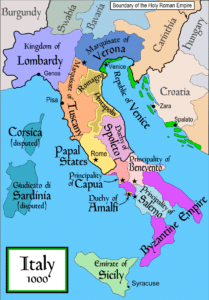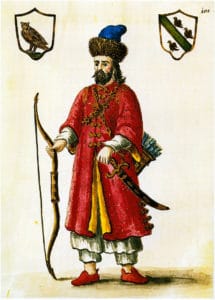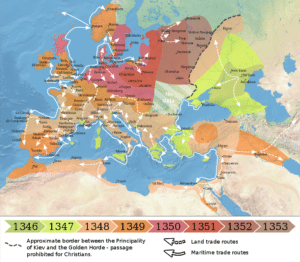
Venice and Genoa were Europe’s main gateway to trade with the East, and a producer of fine glass, while Florence was a capital of silk, wool, banks and jewellery. The wealth such business brought to Italy meant that large public and private artistic projects could be commissioned. The republics were heavily involved in the Crusades, providing support and transport, but most especially taking advantage of the political and trading opportunities resulting from these wars. Italy first felt huge economic changes in Europe which led to the commercial revolution: the Republic of Venice was able to defeat the Byzantine Empire and finance the voyages of Marco Polo to Asia; the first universities were formed in Italian cities, and scholars such as Thomas Aquinas obtained international fame; Frederick of Sicily made Italy the political-cultural center of a reign that temporarily included the Holy Roman Empire and the Kingdom of Jerusalem; capitalism and banking families emerged in Florence, where Dante and Giotto were active around 1300.

In the south, Sicily had become an Islamic emirate in the 9th century, thriving until the Italo-Normans conquered it in the late 11th century together with most of the Lombard and Byzantine principalities of southern Italy. Through a complex series of events, southern Italy developed as a unified kingdom, first under the House of Hohenstaufen, then under the Capetian House of Anjou and, from the 15th century, the House of Aragon. In Sardinia, the former Byzantine provinces became independent states known in Italian as Judicates, although some parts of the island fell under Genoese or Pisan rule until the eventual Aragonese annexation in the 15th century. The Black Death pandemic of 1348 left its mark on Italy by killing perhaps one third of the population.

However, the recovery from the plague led to a resurgence of cities, trade and economy which allowed the bloom of Humanism and Renaissance, that later spread to Europe.
Early Modern:
Italy was the birthplace and heart of the Renaissance during the 1400s and 1500s. The Italian Renaissance marked the transition from the medieval period to the modern age as Europe recovered, economically and culturally, from the crises of the Late Middle Ages and entered the Early Modern Period. The Italian polities were now regional states effectively ruled by Princes, de facto monarchs in control of trade and administration, and their courts became major centers of Arts and Sciences. The Italian princedoms represented a first form of modern states as opposed to feudal monarchies and multinational empires. The princedoms were led by political dynasties and merchant families such as the Medici in Florence, the Visconti and Sforza in the Duchy of Milan, the Doria in the Republic of Genoa, the Mocenigo and Barbarigo in the Republic of Venice, the Este in Ferrara, and the Gonzaga in Mantua. The Renaissance was therefore a result of the great wealth accumulated by Italian merchant cities combined with the patronage of its dominant families. Italian Renaissance exercised a dominant influence on subsequent European painting and sculpture for centuries afterwards, with artists such as Leonardo da Vinci, Brunelleschi, Botticelli, Michelangelo, Raphael, Giotto, Donatello, and Titian, and architects such as Filippo Brunelleschi, Leon Battista Alberti, Andrea Palladio, and Donato Bramante.
